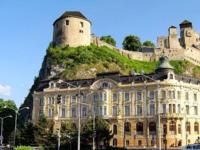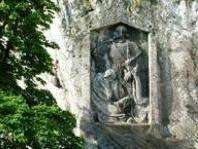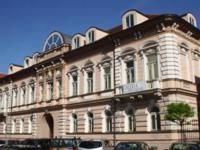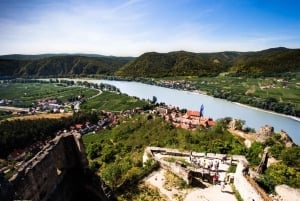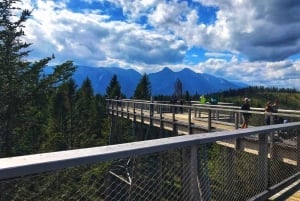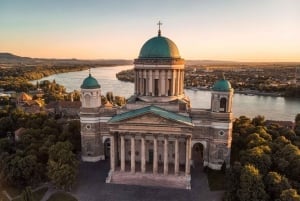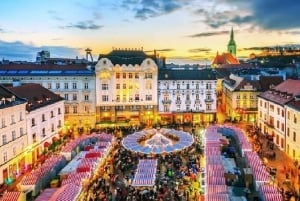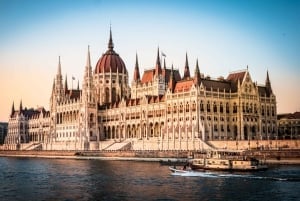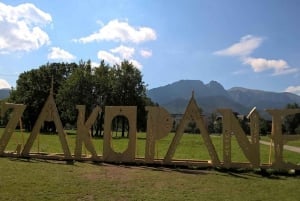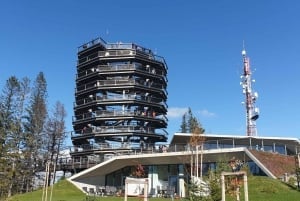Trenčín
Trenčín lies in the valley of the River Váh. Surrounded by mountains - Biele Karpaty (White Carpathians) from the west, Považský Inovec from the south and Strážovské Mountains from the east. The geographical advantages became of strategic importance and are related to the development of this town in the past. Stone age settling of the Trenčín locality is confirmed from archaeological findings. Original proof regarding the presence of Roman legions on Slovak land is the roman inscription carved into the Trenčín Castle rock.
It is a memorial to the victory of Roman emperor Marcus Aurelius over Quadi tribes in year 179. The starting of the town can be traced underneath the massive castle in a trade settlement mentioned in the year 1111 on the old route from the ford under the hill Brezina. History of the castle and of town was for following centuries very closely connected. The largest boom was in 1275, when the castle became property of Matúš Čák, one of the little kings within the Kingdom of Hungary. During the middle ages Trenčín gained privileges and advantages, the trades and skills were being developed, there were annual markets and from the year 1380 there was a brewery. Thanks to King Žigmund Trenčín became the city kings in 1412 with the freedom of kings. It also experienced plenty of catastrophes mainly suffered from wars. The development of the town did not stop and from the second half of the 19th century when Trenčín became an important business and industrial centre of the Váh Valley (Považie).
Thanks to its location it does not lack investors and belongs to one of the dynamically developing towns in Slovakia. Quality schools are secured by two high schools and two universities - Trenčín university of Alexander Dubček and a branch of the American City University Bellevue.
Thousands of visitors come to the town to see Trenčín castle in its full beauty and to hear the most famous myth about the well of love. Stories from the past are told by museums, galleries and will feast your eyes, castle rock will remind of roman times when Trenčín was known as Laugarício.
The city breaths colourful and cultural social city life especially during the summer. Come and have fun at the largest open-air festival of Slovakia - Pohoda, visit the film festival ArtFilm, in August Trenčianske historické a hradné slávnosti (Trenčín historical and castle celebrations) or autumn festival of traditional folk entertainment Pri Trenčianskej bráne (at Trenčín's gate), or take advantage of the other options on how to spend time pleasantly in our town. The number of cultural events, interesting things and tourist attractions are not only offered by the town of Trenčín, but by the whole region.
SIGHTS IN THE HISTORICAL CENTRE OF THE CITY:
Trenčín Castle
The Trenčín Castle was built over a settlement site that had existed from the Bronze Age through times of Celts and Germanic tribes to the Slavic settlement. In the times of the origins of the Ugrian State a royal castle had developed out of the older Great Moravia hill-fort-roost. The oldest stone construction of the castle is the pre-Romanesque rotunda which dates back to Great Moravia period.
Parish Stairway
The Renaissance Parish stairway was built in 1568 as a defence passageway serving the members of the city art's guilds to defend city walls ranging from the St. Michael's Carner to the castle.
At the same time it also served as an access road to the City armory, built in 1565 next to the carner. The stairway was damaged by fires in the years 1708, 1790 and 1886.
After its restoration, the stairway was used as a public communication. It connected the middle of the City with the area of Parish church, the castle and later with the Brezina woods.
Roman Catholic Church of the Birth of Virgin Mary
Built in 1324, the church is a three-nave Basilica-type structure with a simple right-angle presbytery and a protruding-front-positioned tower on the west side. Around the first half of the 15th century, the church was reconstructed into a hall-like three nave structure with a polygonal presbytery. In 1528, during a besiege of the castle by Katzianer, the church and the nearby St. Michael's carner burned down. Wtih permission by the king, repair work began in 1553.
The reconstruction was overseen by an Italian builder Tobias Sebastiano. From 1553-1560, Sebastiano built new nave walls, roofed with arched vault with lunettes on Tuscan pillars. He also built a cellar underneath the sanctuary. The project was finished by Mikuláš Bussi. Throughout its history, the church has been damaged by fire many times. After a fire in 1886 and at the beginning of the 20th century, the church was rebuilt into today's shape.
House of the City's Executioner
The house dates back to 1580 and can be seen in the oldest vista of Trenčín. In the 17th century, according to folk legend, it served as the city executioner's home as well as a prison. More like the house received its name during the 19th century, when the city pandour purportedly lived there.
The house is the only preserved evidence of the shape of a medieval burgher's house in Trenčín. It is thought to have been a gothic style structure originally that was updated in the Renaisssance style. The house is a three stories high building with two-dimension disposition and a wooden circular-trajectory courtyard gallery, is located on Matúš Čák Street by the road leading to the castle.
Currently, it is administrated by the Museum of Trenčín, the expositions 'Law and order in the old Trenčín' and 'From the old Trenčín' are located in the ground floor, the upper floors serve as an exhibition hall.
Museum of Wheels ETOP
Museum of wheels in Trenčín specializes in technology, wich documents the evolution of wheels from ancient times until today - rock wheels (3,500 years BC), wooden wheels (from beginning of the 19th and 20th century), car wheels, bicycle wheels, pre and post war times, iron rubber and plastic chains, security systems, aluminium discs, iron discs and carriage wheels, agro-wheels, trains, planes etc.
St. Michael's Carner
Except for Trenčín Castle, it is the only substantially undamaged Gothic building in the city. The Carner was built in the second half of the 15th century as a bone house (kostnica), near the Parish Church.
Its rear wall connects to the original city fortification. In the beginning of the 16th century the over-ground part was added. After a fire destroyed the church in 1528, it served as a temporary chapel and place of worship. Expenses for repair works in years 1529 and 1530 are recorded in the city's accounts. Due to the threat of Turkish invasions in 1560, the chapel was remodeled into an armory with metal-casting equipment in the cellar. The building deteriorated and after it was reconstructed between 1973 and 1989, it became the property of the Museum of Trenčín.
The District House (at present the Museum of Trenčín)
The museum originally served as a city palace of the Illésházy Family and is located near the Upper city gate. Built in the 17th century, late Baroque adjustments were made to the palace between 1760 and 1764.
The original four nave ground-plan was modified by the addition of another floor, a passage hall, a staircase with Tuscan columns and by making adjustments to the front of the palace. A portion of the inner arcade yard has been preserved. After moving the Trenčín District seat from the Trenčín Castle to the city, the palace served as the district offices and district representatives were meeting on the first floor of the main hall. At present, the District House is the seat of the Museum of Trenčín.
Roman Inscription in Hotel Tatra
The most important Roman epigraphic monument in Central Europe north of the Dunaj (Danube) river, preserved 'in situ'. In the last third of the 2nd century, the invasion of Germanic tribes of Marcomanni and Quadi started one of the most dangerous cenflicts between the Roman empire and tribes of the Danube river. In 179, the last year of the war, detachment troops of the Second Auxiliary Legion (II Legio Adiutrix) penetrated from a garrison in Aquinc (today the city of Budapest) through the Váh river valley as far as Laugaricio, today's Trenčín. Their presence in the surroundings of the city is commemorated by a Latin inscription on the castle rock:
'To the victory of emperors, dedicated by 855 soldiers of II. Legion of an army stationed in Laugaricio. Made to order of Marcus Valerius Maximianus, a legate of the Second Auxiliary Legion'. The authenticity of the inscription and an identification of the donator, a legate of the Second Auxiliary Legion, was made possible by the unique discovery in the Algerian town of Zana (formerly called Diana Veteranorum in the Roman province of Numidia). This unique monument carved to the castle rock is visible from the terrace of hotel Tatra.
Hotel Tatra
Built by baron Armin Popper in 1901 in line with elements of the Secession style, according to a design by E. Bleier. The building was erected on the site of an older inn called 'At the Red Star'. The hotel was named after the emperor Francis Joseph's wife Elizabeth (today's cafe Sissi bears her name).
In 1919, the hotel was purchased by Tatra Bank, and in 1921 the name was changed to Tatra Hotel. The facade's pseudo-Baroque ornaments of plants and figures converge into the Seccesion stylization. For over one hundred years the hotel has been a city landmark and an important center of social life. In 1991, the hotel became the property of the City of Trenčín.
Relief of Ján Jiskra of Brandýs
In years 1915-1916, the Relief of the Victorious Hungaria was carved in the castle rock as a symbol of heroism of the former Ugria.
The relief was designed by the sculptor Michal Kara. Due to ideological incompatibility with a political line of the new republic, the Hořice Stone-cutting school along with the academic sculptor František Duchač-Vyskočil, made in 1921 the Relief of Ján Jiskra of Brandýs as a symbol of brotherhood of the two nations. It is located in the northern side of the castle rock, behind Hotel Tatra.
Mierové Square
The square has an elongated form which shape has been changed through centuries. Building townhouses was the activity that impacted the square's character the most. The Jesuits built their church and convent on the square between 1652 and 1657. The statues of St. Ján Nepomucký and Plague Pillar were erected in the 18th century. Statue of St. Florian, symbol of fire protection, was built in first years of the 19th century.
New buildings including the City Hall, District House, Post Office, Casino and Hotel were gradually added. The square has born various names in the past, such as Intra Moenia (15th century), Civitas (15th-16th centuries), Teatrum, Rink and Forum Publicum (1771-1785), Hauptplatz (middle of the 19th century), Főpiac and Főtér (1868-1911), Szalavszky Gyula-tér (1911-1918), Masarykovo Square (1919-1938), Hlinkovo Square (1938-1945), Stalinovo Square (1945-1962), and its current name is Mierové námestie (since 1962).
After an extensive construction and architectonic survey, the square was declared Municipal Monument Reserve.
Plague Pillar
The pillar was built in 1712, in the center of the square to commemorate a plague that hit Trenčín in 1710. Vienna stone-cutting masters that were working on the restoration of the Piarist Church at the time, created the pillar after the initiative of hereditary Lord of District, earl Mikuláš Illésházy.
Zlatá Fatima Passage
The original passage was built after the great fire in 1886, starting at the ground floor of Zlatý Baran Hotel. This connected the square with today's Palackého Street and it provided easier access for the firemen to the city center.
In 1921, the passage way was closed was closed with the Bio Zora Theatre building. The today's passage is the most modern manifestation of construction adjustments using original alloy pillars.
Gallery of Miloš Alexander Bazovský
Established in 1969, the gallery bears its name after Miloš Alexander Bazovský, who lived his last two years in Trenčín. It offers a unique collection of Slovak art of the 20th century, as well as a permanent exposition of the works of Miloš Alexander Bazovský in reconstructed facilities of the Palace from the last quarter of the 19th century.
With its collection volume, the Gallery belongs to other significant institutions of its kind in Slovakia.
Piarist Church of St. Francis Xaverský
Founded by the Jesuits in 1649, the church's cornerstone was laid in 1653. The Jesuit, later Piarist Church of St. Francis Xaverský, was built in the early-Baroque style from 1653 to 1657, as one-nave building with side chapels with top opening emphoric oratories.
Italian builder Pietro Spazzo, together with his brother Berhard, supervised the construction. The building follows the middle European style of the two-tower Jesuit temples as shown by the St. Francis Church in Vienna. The painted murals in the church are based on the legends about St. Francis Xaverský. After a fire in 1708, Krištof Tausch, a student of a Jesuit artist Andrea Pozzo, produced the paintings in the late-Baroque style during the years 1711 - 1713. An illusive painting of the dome above the church nave belongs to the best of the Baroque arts in Slovakia. Paintings of the choir, presbytery and altar painting of a saint are Tausch's work.
The monumental main altar is from 1767. B. Baumgartner made sculptural decoration of the side altars from 1723 to 1735. The monument is accessible during religious services.
The Lower City Gate
The six floor Gothic tower of the city gate was built around the beginning of the 15th century on a square foundation. Originally, it was a two story structure with its passage roofed by a pointed Gothic arch. During the first quarter of the 17th century the gate was updated in the Renaissance style, a third floor was added in an octogan shape. Damaged during the besiege of the castle by Katzianer, the gate was reconstructed between 1543 and 1549, and erected higher and fortified by the semicilcular barbican with a lower front bastion. A drawbridge served as the entrance. At the top of the tower a Renaissance mechanical clock was installed and in 1934 changed to an electric clock. A Latin inscription on the tower says: 'Until the Lord guards the City, the watchman stays awake in vain'.
Štúr Square
The square took its name from an important from an important Slovak historian, the founder of the Slovak language Ľudovít Štúr. It is situated in a former suburb which was a central space outside the city walls. After the walls were demolished (1837-1873), the original brick buildings were substituted by brick buildings of guild members and tradesmen. Markets with cattle and grain were held there and thanks to this it derived its name as the grain market.
The biggest attraction nowadays is a statue of a waterman Valentine by the sculptor Igor Mosný dating from 1998. In summer the waterman is a big attraction especially for children who enjoy the water jumping in the space and in winter it becomes a centre points of an artificial skating rink for public use.
The most interesting building on the square is the house number 18 which is decorated by a statue of the waterman. It dates from year 1904 with an interesting facade of Secession ornaments.
Synagogue
The Trenčín synagogue belongs to the most exquisite and interesting works of its type in Slovakia. It was built close to an earlier synagogue. In 1913, the Trenčín construction firm Fuchs and Niegreisz, carried out the construction based on the blueprints of a Berlin architect Dr. Richard Scheibner.
The historic building with Byzantine and Maur-Oriental elements stands at the northern corner of the Ľudovít Štúr Square. The Synagogue was used for neology purposes until the Second World War during which it was desecrated and its articles taken. Reconstruction of the monument took place from 1974 to 1984. After the reconstruction the central space under the dome has served as an exhibition hall. A small worship room in the rear of the facility was restored in 1990. The monument may be accessed at times of occasional exhibits.
City Walls
Works on the City Walls possibly began after year 1421, when Trenčín became a free city with the right of city walls. It was completed in the first half of the 15th century. Citizens focussed especially on the security of two town gates - Upper Gate (Water) and Lower Gate (Turkish), which controlled the entry to Mierové Square.
Nothing was preserved from the Upper City Gate which was situated in the north part of the main square opposite to the main flow of the River Váh and destroyed in 1873.
Lower City Gate closes the south part of Mierové Square and it is accessible in summer months - from June until September. Barbican which was possible to enter through a drawbridge was part of the southern city walls and was destroyed in 1857. The oldest part of the city walls are preserved in its southwestern part in the section behing Karner of St. Michael, which was connecting Lower City Gate with the southern fortification of the castle. In 2008 in the southern suburban the original exterior City Walls were discovered and named as a national cultural heritage.


